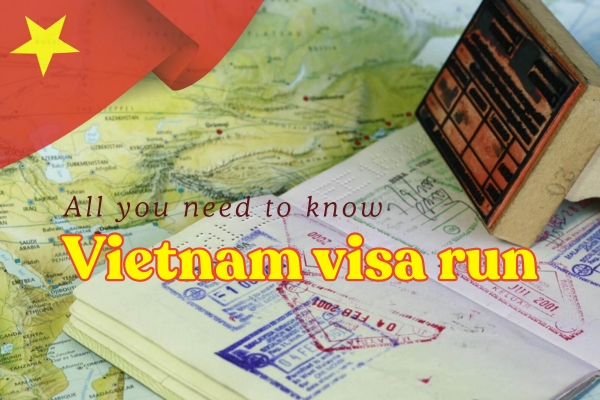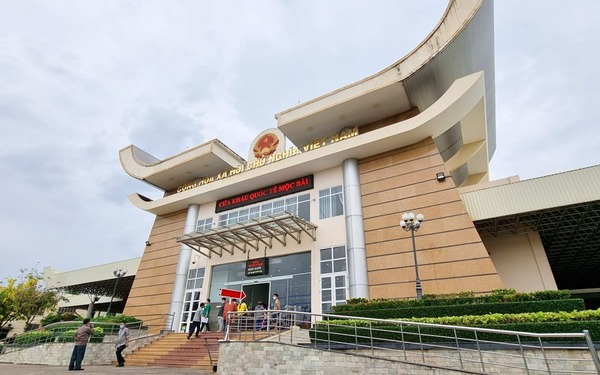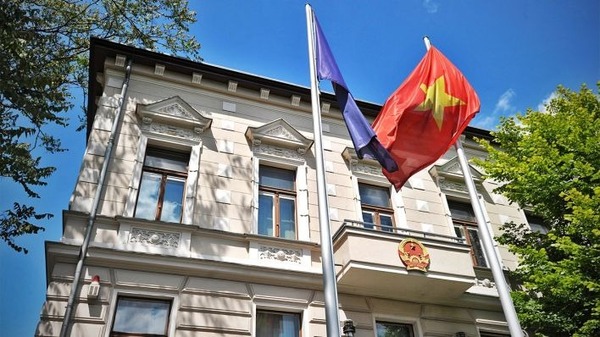Visa run Vietnam – All you need to know
Vietnam visa run is a solution to quickly extend your visa without complicated procedures. Not everyone understands the process, costs and convenient destinations for an effective visa run trip. This article will provide you with all the information you need to know about Visa run Vietnam, from the implementation process, convenient destinations to important notes before departure.

What is a Vietnam visa run?
A Vietnam visa run is a common method used by foreigners who wish to continue staying in Vietnam after their current visa is about to expire but prefer not to extend it due to high costs or other reasons. A visa run means taking a short trip from Vietnam to a nearby country.
This could be Laos, Cambodia, Thailand, or China. You stay there for a few hours or a couple of days. Then, you return to Vietnam with a new visa.
This process must be done before the current visa expires. This ensures that travelers can re-enter Vietnam legally with a new visa and a renewed stay.

Why visa run Vietnam?
A visa run means travelers must leave and then re-enter Vietnam. This process has many benefits. It is a popular choice for expats and long-term visitors.
- Simple process and lower cost: Extending a visa in Vietnam can be costly. It often needs a local sponsor or a visa agency to manage the paperwork. A visa run is usually quicker, easier, and cheaper. It lets you get a new visa without complicated steps.
- Flexible visa options: While visa extensions are often limited in terms of duration and number of entries, a visa run gives you greater flexibility. Depending on your travel plans, you can apply for a 1-month or 3-month visa, and choose between single-entry or multiple-entry options providing more control over your stay in Vietnam.
Advantages and disadvantages of Vietnam visa run
Advantages of Vietnam visa run
A Vietnam visa run gives travelers a flexible and easy way to manage visa expirations. However, like any option, it has both pros and cons. Let’s take a closer look at the key advantages:
- Quick processing: A visa run can often be done in just a few days. In contrast, a regular visa extension may take weeks or even months to process.
- Cost-effective solution: Sometimes, doing a visa run costs less than renewing a domestic visa. This is especially true when in-country extension fees are high.
- Flexible timing: Travelers can choose when and where to do their visa run. This lets them plan based on their schedules and preferences.
- Travel opportunity: A visa run can also be a mini getaway. It allows travelers to visit nearby countries or areas. This makes the experience both useful and fun.

Disadvantages of Vietnam visa run
Visa Run Vietnam is a legal and popular option when done correctly. However, it can have risks and problems if not handled well or used too often.
- Potential risks and uncertainties: A visa run means leaving and coming back to Vietnam. Travelers may face unexpected problems. These can include changes in immigration rules or being denied entry based on the rules of the destination country.
- Lack of long-term stability: Relying only on visa runs for extensions can create uncertainty. This is especially true if immigration rules change suddenly. Such changes can affect your ability to re-enter or stay longer.
- Time and effort required: Although a visa run is relatively fast, it still demands time, energy, and logistical planning. Crossing borders, managing paperwork, and dealing with immigration formalities can be tiring and stressful.
Note:
- If you are not sure about your visa options, talk to a professional.
- If your visa is about to expire, it is also a good idea to seek help.
- Consider using a service like Wexplore Vietnam. With years of experience, their team offers quick advice and effective support. They help you complete your visa process smoothly and legally.
Type of visa run
Currently, foreigners in Vietnam can choose between two main types of visa runs: the visa run by air and the visa run by land. Each option offers different levels of convenience, cost, and travel experience.
Visa run by air
A visa run by air refers to exiting and re-entering Vietnam via international flights. This method is especially popular among foreigners living in Hanoi, as it is fast, convenient, and offers multiple destination options.
Foreigners can choose from eight international airports in Vietnam for their visa run:
- Noi Bai International Airport – Hanoi
- Tan Son Nhat International Airport – Ho Chi Minh City
- Da Nang International Airport – Da Nang City
- Cat Bi International Airport – Hai Phong City
- Cam Ranh International Airport – Khanh Hoa
- Phu Quoc International Airport – Kien Giang
- Lien Khuong International Airport – Da Lat
- Can Tho International Airport – Can Tho City

Visa run by road
A visa run by land means leaving Vietnam through a border crossing. This is usually done with Laos or Cambodia. After that, you can re-enter Vietnam through the same or a different border gate.
Many foreigners living in Central and Southern Vietnam prefer this option. It is usually cheaper than flying. There are 16 official land border gates where foreigners can perform a visa run by road:
- Bo Y Border Gate (with Laos)
- Cha Lo Border Gate (with Laos)
- Ha Tien Border Gate (with Cambodia)
- Huu Nghi Border Gate (with China)
- Cau Treo Border Gate (with Laos)
- Lao Bao Border Gate (with Laos)
- Lao Cai Border Gate (with China)
- La Lay Border Gate (with Laos)
- Moc Bai Border Gate (with Cambodia)
- Mong Cai Border Gate (with China)
- Na Meo Border Gate (with Laos)
- Nam Can Border Gate (with Laos)
- Tinh Bien Border Gate (with Cambodia)
- Song Tien Border Gate (with Cambodia)
- Xa Mat Border Gate (with Cambodia)
- Tay Trang Border Gate (with Laos)
Who is eligible?
A Vietnam visa run is applicable to foreigners who fall under one of the following categories:
- Foreigners entering Vietnam under visa exemption
- Foreigners holding a 5-year visa exemption certificate
- Foreigners entering Vietnam with a 30-day E-visa
- Foreigners entering Vietnam on a business visa
Where to do a visa run from Vietnam?
There are two main ways to perform a visa run from Vietnam:
- By air: Exit and re-enter Vietnam through one of the country’s international airports.
- By land: You can travel by land to a nearby country like Laos or Cambodia. Go through a border gate, then return to Vietnam with a new visa.
Vietnam visa run tips:
- Cheapest visa runs from Hanoi: People in Hanoi often fly from Noi Bai International Airport to nearby countries. These countries include Singapore, Thailand, and Cambodia. These routes are affordable, convenient, and have frequent flight options.
- Cheapest visa runs are available from Ho Chi Minh City (Saigon): Many expats in Ho Chi Minh City or nearby areas often choose the Moc Bai visa run. This run is located at the Cambodian border. Many people see it as the fastest, cheapest, and easiest way to renew your visa in southern Vietnam.

What to bring on a visa run Vietnam?
When preparing for your visa run Vietnam, make sure to have all the necessary documents ready to ensure a smooth process. Here’s what you’ll need:
- Original passport: Valid for at least 6 months from your re-entry date into Vietnam, with at least two blank pages for visa stamps.
- Current Vietnam entry documents: Such as a 5-year visa exemption certificate, E-visa, or Vietnam entry approval letter (for business visa holders).
- Outbound ticket: Either a flight, bus, or train ticket showing your exit from Vietnam.
- Valid entry documents for the third country: A visa or entry permit, if required by the country you’re visiting for the visa run.
- 1 ID photo (size 4×6 cm): Needed for visa stamping at the border gate (if required).
- Black or blue ink pen: To fill out the immigration or entry declaration forms.
- Visa stamping fee (if applicable).
See more>> Vietnam Visa photo Size and Requirements
Important notes:
- If you are exempt from a visa, items (2) and (3) are not required.
- Travelers doing a land visa run need to show the original visa approval letter. This letter must have an official red stamp and signature. Copies, scans, or photos of the letter will not be accepted.
- Ensure your ID photos meet Vietnam visa requirements. If you forget to bring them, you may be charged around $2 per photo at the airport or border gate. Photo services are available almost everywhere in Vietnam and usually cost 50,000 – 100,000 VND.
- The visa stamping fee at Vietnam airports is 25 USD for a single-entry visa. For a multiple-entry visa valid for up to 3 months, the fee is 50 USD.
- You can get the Vietnam visa application form in a few ways. If you are applying at the airport, you can collect it on the flight. You can also find it at the visa-on-arrival counter at border checkpoints. Alternatively, you can download it HERE.
How to apply
If you want to renew your visa with a Vietnam visa run, prepare the right documents. Follow the steps carefully. Below is a detailed guide to help you complete the process smoothly.
Dossier
Your passport must have at least two blank pages for visa stamps. It should also be valid for at least 6 months after you return.
- Original passport: Must have at least two blank pages for visa stamps and be valid for a minimum of 6 months after your re-entry date.
- Vietnam visa documents: This includes your 5-year visa exemption certificate, E-visa, or visa approval letter. For visa run by land, you must bring the original visa approval letter. For visa run by air, a printed copy of the visa approval letter is acceptable.
- Air or bus ticket.
- Required entry documents for the third country, such as a visa or entry permit, if required.
- Visa stamping fee: You pay this when you re-enter Vietnam. It usually costs 25 USD for a single-entry visa. A multiple-entry visa for up to 3 months costs 50 USD.
- Two (2) passport photos (4×6 cm): Photos must be identical, taken within the last six months, facing forward, and without hats or glasses.
- Vietnam visa application form: Required for land border visa runs; available at the border gate or downloadable in advance.

Procedure
Follow these five steps to complete your visa run and obtain a new Vietnam visa:
Step 1: Prepare all documents
Ensure you have every document ready before traveling. If you need a visa for the third country, you have two options. You can get the visa at the airport when you arrive. Alternatively, you can obtain it at the Embassy or Consulate in Vietnam.
Step 2: Exit Vietnam
Proceed through the exit procedure at the airport or land border checkpoint. Once you receive the exit stamp, travel to the third country by plane, bus, or train.
Step 3: Enter the third country
Present your documents to immigration officers to complete entry procedures for the third country. Depending on your visa or permit, you may stay briefly or proceed directly to your return trip.
Step 4: Exit the third country
You can choose to return to Vietnam immediately or stay in the third country for a few hours or days. Before re-entering Vietnam, ensure you have your exit stamp from the third country.
Step 5: Re-enter Vietnam and complete the visa process
When you return to Vietnam, bring your original passport. You also need your visa application form, two passport photos, and your visa approval letter or E-visa. Don’t forget to include the stamping fee.
Your new visa will be stamped at the Vietnam airport or land border gate, completing the visa run process.

See more>> Urgent & Emergency Vietnam Visa
Processing time & fee
The processing time and fees for a Visa Run Vietnam can vary depending on your specific travel needs, visa type, and method of application.
Processing Time
- Vietnam visa on arrival or E-visa: Usually takes 3–7 working days to be issued.
- Visa to enter the third country: Processing time typically ranges from 3–7 working days, depending on the country’s requirements.
- Time spent in the third country: You may need to stay for a few hours to a few days, either to complete immigration and exit procedures or to enjoy a short trip before re-entering Vietnam.
Fees
Your total visa run cost will include one or more of the following fees, depending on your visa type and number of entries:
- E-visa fee: US$25
- Visa approval letter fee: Varies depending on the agency or service provider you choose.
- Visa stamping fee (upon re-entry to Vietnam): US$25 for a single-entry visa, US$50 for a multiple-entry visa (valid for up to 3 months).
Important notes when doing visa run
Before planning your Visa Run Vietnam, take note of the following important guidelines to ensure a smooth, safe, and legal trip.
Prepare your documents carefully
- Double-check your passport validity; it must be valid for at least 6 months beyond your re-entry date and have enough blank pages for visa stamps.
- Gather all required documents, including your Vietnam entry permit, return flight or bus ticket, and the visa or entry permit for the third country (if needed).
- Apply for your third-country visa early to avoid delays that could affect your travel schedule.
Research the third country
- Check the entry requirements, visa policies, and length of stay regulations of the country where you plan to do your visa run.
- Learn about local culture, customs, and safety to prepare appropriately.
- Book accommodation and transportation in advance to avoid high costs or unavailability, especially during busy seasons.
Choose the right timing
- Avoid traveling during peak tourist seasons to reduce expenses and waiting times at border gates.
- Allow sufficient time for travel, immigration procedures, and rest in the third country.
- Stay updated on health regulations, epidemics, or travel restrictions that may impact your trip.
Stay safe and comply with the law
- Always carry your passport, visa, and travel documents with you during the journey.
- Respect and comply with the laws and immigration rules of the country you are visiting.
Additional notes
- The visa run process may vary depending on the third country, so always check for the latest updates from the Vietnamese Embassy or Consulate.
- Costs may differ depending on your destination country, visa type, and service provider.
- Frequent or multiple-entry visa runs may affect your immigration record, so consider carefully before proceeding.

Answering questions about visa run
Below, Entry Visa Vietnam compiled clear, easy-to-understand answers to the most common questions travelers ask before planning their next visa run.
Is visa run the best way to extend my stay in Vietnam?
It depends on your situation. If you prefer convenience and higher success rates, using a local visa agency for an extension before your visa expires is ideal. You can also apply yourself if you have a Vietnamese sponsor, but it involves more paperwork.
A visa run is often cheaper and simpler, though it requires you to exit and re-enter Vietnam. Each method has its pros and cons choose based on your budget and time.
Are photos compulsory when immigrating to Vietnam by visa run?
No, photos are only needed if you get a visa on arrival at a Vietnamese airport. In that case, prepare two identical passport photos (4x6cm) taken within the last six months, facing straight, without glasses or hats.
Is visa run applied for all border gates in Vietnam?
No. You can do a visa run by air through one of eight international airports, or by land via one of 16 official border gates.
Which country should I choose for visa run?
Depending on where you live in Vietnam, here are some of the most cost-effective visa run routes:
- From Hanoi: Visa run by air from Noi Bai International Airport to Thailand, Malaysia, or Singapore.
- From Ho Chi Minh City and the South: Moc Bai visa run (Cambodia) – ideal for quick and inexpensive renewals.
- From the Central region: Lao Bao visa run (Laos) – popular among expats in Da Nang, Hue, and Quang Tri.
Does visa run affect future visa renewal?
Generally no, as long as it’s legal and you don’t overstay. However, frequent visa runs may raise concerns about your intent to reside long-term or may be restricted by immigration policies.
Above are some essential tips and experiences to help you prepare for your Vietnam visa run with confidence. If you’re looking for a reliable, fast, and hassle-free way to apply for a visa, contact Wexplore Vietnam today. Our expert team will handle all the paperwork and procedures, so you can focus on enjoying your time in Vietnam without any visa worries.

